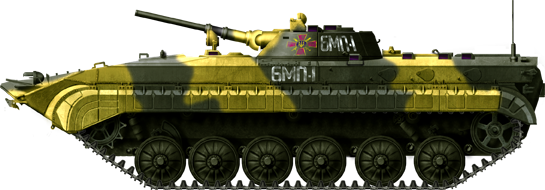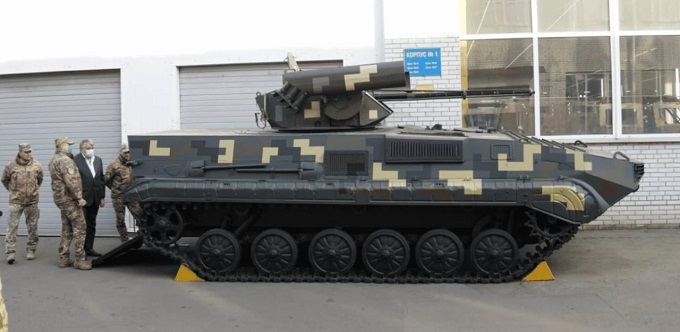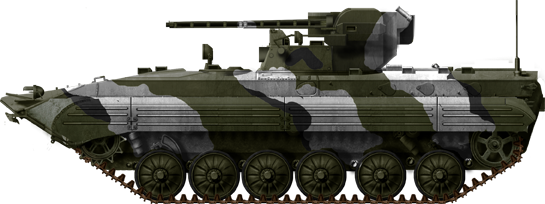BMP-1U Shkval (2001)
 Infantry Fighting Vehicle, c30 built
Infantry Fighting Vehicle, c30 built
The BMP-1 was of course part of the Ukrainian inventory back in 1991 after the Independence act of 24 August. In fact, Ukraine had Around 2,525 of these still in service in 1994, but just 1,325 in 1995, 1,011 in 2000 and 1,008 in 2005 alongside 490 specialist BRM-1Ks by 1995 down to 458 in 2005. The vehicle was considered obsolete ny NATO standards and it was urgent to modernize them, not only to renew the domestic park, but also to sell upgrade kits to users abroard. The main variant became the BMP-1U as a standard many others being converted as ARVs and completed by modern Czech BVP-1s. But Ukraine also proposed the BMP-1M (Object 765UTB), BMP-1UM, BMP-1UMD and BMP-1TS, a wide array of home-grown upgraded variants, some sold to Vietnam, which also created its own domestic XCB-01.
Development

Ukrainian BMP-1 in the 1990s. Most were lost in action after the 2022 invasion.
The BMP-1U was an Ukrainian upgrade of the BMP-1 developed by the State Scientific and Technical Centre of Artillery and Small Arms, located in Kyiv, probably from 1999. The main exercises was to keep the chassis unchanged (but with an overhauled power unit) while replacing the turret by a new domestic one, the KBA-105 Shkval ("squall"). The latter was a remote weapon station (RWS) developed for such vehicles (also compatible with BTRs), to increase lethality. The Shkval turret system alone was first displayed publicly at IDEX 2001 arms expo in Abu Dhabi and mounted on the BTR-3U APC, an Ukrainian derivative of the BTR-70. It had nothing to with the relatively similar KBP turret developed by Instrument Design Bureau as the TKB-799 Kliver weapons station.
So far, their status is not known since the 2022 invasion. Russian propaganda showed a single captured "Ukrainian BMP-1U" but the OSINT community pointed out it was likely an ex-Georgian captured vehicle. Indeed, the vehicles were first revealed publicly in the Kyiv parade for its Independence Day on August 24 2001 and tne BMP-1Us were visible. In 2004, state trials followed by an order for 400 upgrades tô equip 3 mechanized brigades went nowhere. The reasons are no well known, but ity's likely the cost rose while finances did not followed. Onlu 30 BMP-1Us were ever produced according to most sources.
So far, the Ukrainian Armed Forces are known to operate 12 and the remaining 15 were sold to Georgia in a 2007 agreement, delivered just before the 2008 Russian invasion of Georgia when they were all lost in action and 5 captured undamaged in Gori. Three were also sold to Chad, fighting ISIS in 2013. In April 2022 a trophy Ukrainian BMP-1U was shown as formerly captured "somewhere in Crimea" with its typical "Z" markings. The OSINT community argues that it could have been one of the earlier Georgian trophies, opportunistically used. According to Oryx blog, this vehicle is listed as one Ukrainian BMP-1U. Alongside these, some 391 BMP-1(P) were reported lost, 2 BMP-1TS and six Czech modernized BWP-1. According to previous data, it means that no more than 100 BMP-1s would be left available for conversion, if any.
Armament

Main gun ZTM-1 (2A72)
The Shkval RWS is armed with the ex-Russian locally produced 30 mm 2A72 automatic cannon or the purely Ukrainian ZTM-1 equivalent. It comes with belts (dual feed) with 360 rounds of ammunition, prolongated onboard with a coaxial PKT 7.62 mm machine gun or Ukrainian KT-7.62, which comes with 2,500 rounds.The main weapon ZTM-1 (2A72) has a Rate of fire of c330 shots/min a reloading electromechanical, with manual backup, dual feed, electric. The main gunner sight enables to hit with some accuracy a target distant of two kilometers with the BT and BZT shells and up to four km with the VID and OFS projectiles. Cailing against helicopter and low flying aicraft is around 2000 m and in direct fire, practical range is 1100 m. If the main power source fails it is still possible to fire and reload it manually.
It uses the Weapon stabilizer SVU-500-3C, electric, 2-plane, with "Semi-automatic" mode in -4 to +60° elevation, and 360° traverse.
ATGM Launcher
The cherry on the cake, outside the performances of the 30 mm gun, way better than the former low-pressure 75 mm, are two anti-tank guided missile (ATGM) launchers. They are mounted on the right side of the remote turret module (with other variants having them on both sides). The name is "Complex 212" "Barrier". The RK-2S missiles are guided by the PN-B system, guided by sighting with a useful firing range between 75-and 5000 m. Total reloads had been ported to 4 missiles, six with the two pre-loaded. They are tailored to fire the 9M113 Konkurs missile. Two reload tubes are carried inside to be swapped while staying protected inside.KT Machine gun:
The KT-7,62 is a copy of the PKT, 7.62 capable of firing at 700-800 rpm, up to 2000 mAutomatic grenade launcher:
To provide a complementary anti-personal asset, there is also either a 30 mm AGS-17 or the Ukrainian equivalent KBA-117. This is an automatic grenade launcher, installed on the left side. It is supplied from an ammunition box below, with a conveyor belt, and up to 116 rounds. Also called AG-17 it fires the 18 kg fragmentation grenades of the VOG-17, VOG-17m types at a rate of 50-100 practical and up to 350-400 rpm theoretical. Aiming range is 1,700 m.Grenade launchers:
It is rounded off by a bank of six (defensive 81 mm smoke grenade launchers on the RWS front, at its lower base. Although firing smoke, they could be swapped for explosives. These six 3D6 dischargers can act in 5 minutes, trigerred by optical television device.Fire Control
The OTP-20 Cyclops-1 optical, TV-based complex manages all aspect of the gun automation, ammunition selection, modes, activates the coaxial LMG, the grenade launcher, and includes a complete interface for guiding the ATGMs. The ZTM-1 main gun is fully, dynamically stabilized by the SVWU-500 Karusel system. This fire control system, using the optical-electronic module "Tandem-2" provides both surveillance and detection of ground targets, targeting and control of all weapons in the combat module between the ZTM-1 automatic 30-mm cannon, Automatic grenade launcher AG-17, 7.62 mm machine gun and ATGM "Complex 212" "Barrier".The main Optical sight, the periscopic PZU-7M is capable of a magnification of 1.2 times with an angular field of vision of 50 degrees and enabled aiming and adjusting fire in case of power failure. It is completed by the TKN-3 commander's observation sistem. It had a night sight via low-level television cameras, for target detection and recognition with a visual channel not lighting up during shots and flashes and better survivability.
Communication
The vehicle comes with the R-173m transceiver and telephone in ultra-shortwave using a 4-meter whip antenna capable of reaching 20 km with the noise suppressor turned off, 13 when turned on. It is coupled with the P-174 intercom enabling five connected via their headgear, there is also a back external telephone, linked to the commander via electromagnetic laryngophones.Protection
Ballistic and anti-mine protection comprised the base protection provided by the BMP-1 chassis, with a set aimed at reisting medium-weight armored vehicles. There are on-board screens of increased size with a padding made of aramid fabric. The fuel tanks are placed between the seats and sides, there are new energy-absorbing structures under the raised floor of the landing compartment. There is a reusable thermal smoke equipment, for IR masking (heat-insulating MTO coating, exhaust duct deflector) and a pixel deforming camouflage pattern. The exaust is fitted with the system "Khmara" 902U injecting fuel to create a smoke curtain.Passive protection:
The BMP-1U had a full NBC protection system, with full sealing of compartments, air filtration, overpressure, heating of the combat compartment as well as an air conditioner, powder gas suction fans and water pumping facilities as the vehicle has enough buoyancy to float.
Navigation system:
The CH-3003 navigation receiver determines the current location coordinates, road speed and time based on the radio signals of the GLONASS and GPS satellite navigation systems at any point on the globe, at any time, regardless of weather conditions and outputs the data to the display device and, according standard interface, external consumers of navigation information.It enabled the automatic selection of the optimal navigation constellation, the Integral evaluation of the expected accuracy of determining the current coordinates providing specified parameters to external devices, processing and correction of information, in accordance with the RTCM SC-104 standard. It is also tasked to solve navigation task when working in differential mode, can register 500 route points, up to 50 traffic routes, Memorize current coordinates as a waypoint and Calculate distance and direction between two points of movement along the route as well as coordinates in the WGS-84, PZ-90, SK-42 system with setup by the user, geographic projection display, Gauss-Kruger type.
BMP-1U | |
| Dimensions | 6.73 x 3* x 2.07 m (22.1 x 11* x 6.9 in) |
| Total weight | 14 tonnes est. |
| Crew | 3+6 |
| Propulsion | UTD-20 V6 wc mfuel 15.8L diesel 300 hp (224 kW) 2,600 rpm |
| Suspension | Torsion bars, shock absorbers |
| Speed road/off/swimming | 65/45/7 km/h (40/28/4 mph) |
| Range road/off | 600/500 km (370/310 mi) 462 gal. |
| Armament | RWS SHKVAL, 30 mm ZTM-1, KP LMG, Grenade launcher, see notes |
| Armor | 6 to 33 mm (0.24-1.30 in), addon packages, improved NBC, smoke |
| Total conversions | 30 (est.) |
Evolved Variants
BMP-1M (Object 765UTB) 2011

BMP-1MS Ukraine. Note the raised roof.
Evolved from the BMP-1U this variant was unveiled in 2011 and is fitted with the improved KBA-105TB Shkval-A RWS. Instead of the Konkurs ATGM, the long range Ukrainian Barrier ATGM (5,000 m range) are fitted, coupled with the new Tandem-2 sight and SWU-500-3C weapon stabilization system. Tandem 2 uses two TV cameras and the narrow FOV UTV capable of 6 km detection range, 5 km identification range plus wide FOV ShTK camera to spot tank size vehicles at 3 km. Low-light conditions but not equivalent to true IR.
The system also includes a laser rangefinder. Zhytomyr Armour Plant created it for export, sold to Turkmenistan at a ceremony in 2016, the sale not reported to the UN arms control program.
BMP-1UM (2015)


The Shkval-A remote weapon station used on the BMP-1UM
Another prototype from the Zhytomyr Armour Plant for export, it's a better upgrade wuth the Shkval-A RWS but an overhaul power plant and hull. The new engine is a 3-cyl. 2-stroke 3TD-2 diesel rated for 400 hp with parts shared woth the 5TDF/6TD tank engines. The troop compartment had a hull roof raised by 15 cm, and large ramp at the rear, manually operated.
It is fitted with Kontakt-1 explosive reactive armour (ERA) bricks on the upper hull. The fuel tanks separating troop seating are relocated at a safer place, there are larger side skirts. Aramid fibre spall liner inside, notably under the floor to better absorb/mitigate mines/IEDs explosions. SN-3003 GLONASS/GPS receiver. Improved TKN-3B commander sight to receive all video feeds, better RWS cameras. Reduced thermal signature: New exhaust gas deflector. Larger track fairings for extra buoyancy for swimming.
BMP-1UMD (2016)

BMP-1UMD with Stylet RWS and Deutz turbodiesel engine.
Also from Zhytomyr Armour Plant, showcased at the Arms and Security exhibition. Deutz TCD2013 L64V 6-cyl. TD rated for 330 hp, more reliable and quieter, shared for parts with the BTR-4. Stylet RWS with fully digital fire-control system, new sight Trek-M, SWU-500-3C three plane weapon stabilizer. 30 mm ZT-2 main autocannon, KT-7.62mm coax, 30 mm AG-17 mortar, 2x Barrier ATGM. No ERA bricks but extended mesh covers, upper hull sides. Unchanged troop compartment or access doors. These vehicles were trield, but no orders were made.
BMP-1TS (2021)

Another attempted variant by Ukrainian Techimpex. RWS "Spys" in the works since 2018. 30 mm ZTM-1 autocannon (300 rounds), KT-7.62mm MG (350 ready rounds, 2,100 total), 30 mm KBA-117 mortar (116, 29 ready), Barrier ATGM (2 ready, 2 spares) and Spys module with "Syntez" fire-control system: Kazhan-3K15 sight (thermal and optical TV cameras) plus a laser rangefinder. Electro-mechanical 2-plane weapon stabilization system. Advanced software for automatic target tracking. Smaller and easier to swap with the the original BMP-1 turret, no modifications required. Motorola DM4601 radio proposed and an option and additional mine and ballistic protection. 10 ordered by the Ukrainian defence ministry, showcased at the 2021 Independence Day parade. They saw combat. Indeed one vehicle of the 53rd Mechanized Brigade was lost at Volnovakha in March 2022.
Gallery
Illustrations

Early BMP-1U Shkval

Georgian vehicle, apparently plain green, Russo-Georgian war

Turkmen BMP-1M as shown in the 2016 parade.
Photos

Shkval RWS Kyiv 2019

BMP-1UM left-front view

BMP-1UM side

BMP-1UMD 1-2

BMP-1UMD 2
BMP-1U standard
Sources/Links
uk.wikipedia.orgweaponsystems.net
thesovietarmourblog.blogspot.com
ukroboronprom offers modern modular turret systems at laad 2017
issuu.com/ukrainian_defense_review
army-guide.com
glavcom.blogspot.com
uoe.com.ua
defence-blog.com
zhbtz.com
deutzsupport.com
globalsecurity.org
autoconsulting.com.ua
ukroboronprom.com.ua
zhbtz.com
forum.warthunder.com
tankandafvnews.com/
magnum-x.pl
commons.wikimedia.org
scalemates.com
armedconflicts.com
armyrecognition.com Russia possibly uses Ukrainian BMP-1U Shkval captured in Georgia
Shkval: How Ukraine-Modernized BMPs Ended Up in Russia and Fight Against the Defense Forces
forbes.com Russia's rare-ex ukrainian BMP-1 accidentally ran over some russian infantry...
en.wikipedia.org list BMP-1 variants
Video

Modern Tanks
Modern MBTs posters

Denel Bagder (2018)

Type 16 MCV (2016)

Gepard 1A2 last rounds 2011

SANDF

Russian AFVs

Main Battle Tanks